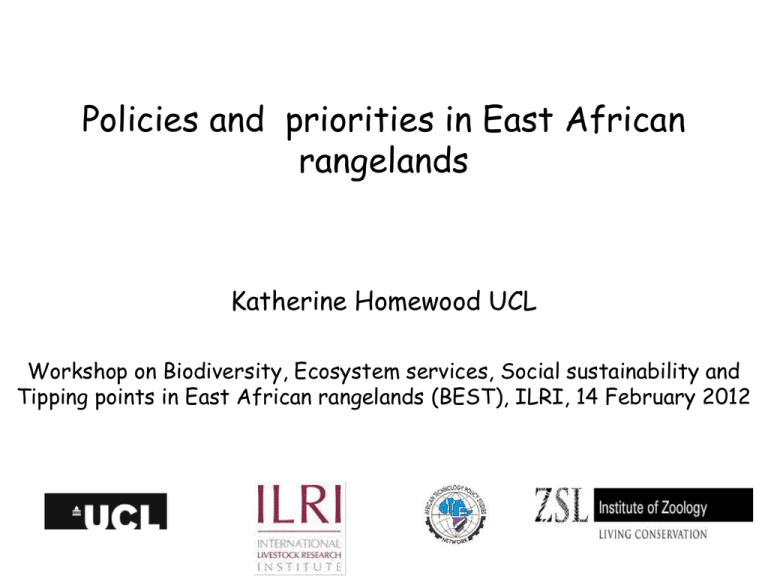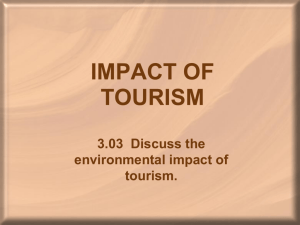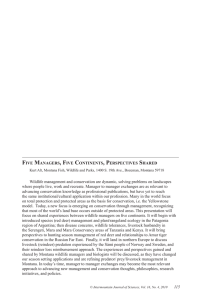Policies and priorities in East African rangelands Katherine Homewood UCL
advertisement

Policies and priorities in East African rangelands Katherine Homewood UCL Workshop on Biodiversity, Ecosystem services, Social sustainability and Tipping points in East African rangelands (BEST), ILRI, 14 February 2012 Katherine Homewood Anthropology,UCL Arid and semi arid lands ASAL • Low agro-ecological potential • Marginal, peripheral areas and populations • Poorly represented in national statistics • Economic contribution not well understood • Persistent poverty But global demand/markets for • Land (and water, and minerals,…) • Food, biofuels, carbon storage, biodiversity • New potential for ASALs? • Implications for current uses and users? African Union 2010 • Affirms • Scale of African local livestock production • Economic benefits /dynamism / resilience • Ecological benefits: environmental sustainability • Calls for action • Protecting pastoralist tenure and access, • supporting and enhancing » mobility, » security, » appropriate services African Union 2010 Policy framework for pastoralism in Africa. Addis Ababa, Ethiopia BUT – Across individual ASAL countries – Negative narratives around pastoralism » ?Unproductive? » ?Environmentally damaging? » ?Backward / in need of modernization? – In depth studies give strong evidence to contrary BUT » Data capture technically demanding » Poorly represented in official statistics » Ecological/economic contributions undervalued – Histories of land tenure and access – Alternative uses favoured – Key resources captured/ converted Current policy and practice across African rangelands • Alternative land uses promoted » Commercial crops (biofuels?...grain?...carbon sequestration?...) » Mining » East Africa: Wildlife tourism • Benefits of alternative uses » » » » Attract global investors Stimulate growth? Trickle down? Wildlife : environmental/biodiversity conservation • Costs of alternative uses » Constrain livestock production and associated market chains » Displace people/ Impact on livelihoods » Displace resource use/ Knock on environmental effects • Tradeoffs or win/wins? And for whom? » Benefits vs costs? » Distribution? Catley et al 2012: Development at the Margins: Pathways of Change in the Horn of Africa Focus on East Africa: • Kenya » Colonial period: settler vs Trust land » Privatization of communal lands » Trust land -> Group ranches -> individual private plots » New Constitution 2010: changes to remaining Trust land » Scramble for key resources • Tanzania » Colonial period: customary “deemed” vs ”granted” land occupancy » Ujamaa: State control overrides customary/ private tenure » Mid-80s liberalisation, Land Acts 1999 » village lands: farmland title vs grazing lands „open‟ » State lease/sale of lands (commercial farms, hunting, tourism) • Ethiopia » State control of land » Large scale land (and water) leasing/sale – Omo River Basin » Ethnic federalism: access assigned among competing groups Across East African rangelands • • • • • • • Formerly communal -> private / State State-controlled land -> investors Taxable returns + entrepreneur profits but Customary users displaced Livelihoods lost Environment fragmented Biodiversity lost Is wildlife conservation + tourism the exception? -> ASAL sustainable economic growth + poverty reduction? Pastoralists, wildlife conservation and tourism – Tourism revenues – ~USD 1 billion/yr each in Kenya and Tanzania – High proportion due to wildlife (viewing ± hunting) – Pastoralist areas = fastest growing destinations – Savanna wildlife Homewood, Chenevix-Trench and Brockington 2012 – Kenya 50-80% 1975-2005 DRSRS, Western et al 2009 – Similar declines in TZ? – Stoner et al 2007, Sinclair et al 2008 – Wildlife and pastoralist livestock both – – Need same key resources maintain rangeland landscapes, biodiversity, tourism revenues -> Green development policies BUT • Opportunity costs of wildlife tourism? • Returns relative to other land uses • Loss of – production (setaside/ key resource capture) – risk management potential / resilience • Costs (vs benefits) to national / local economies • Costs (vs benefits) to livelihoods • Distribution of wildlife returns? • International vs national vs local • State vs entrepreneur vs local user • Inequalities / Poverty implications Relative returns per hectare 350 Rents ($/ha/yr) 300 250 Ag <- Tourism << Livestock returns << crops Norton Griffiths and Said 2008 200 [but: revised values?] 150 100 50 0 0 Lv Mh C&A 200 400 600 800 1000 1200 Mean Annual Rainfall (mm) Ag - Agriculture Lv - Livestock Mh - Mara "High" ($50) C&A - Concession and Access ($10.2) Land use choices that result Household returns from tourism - relative to other land uses? Multi site study across Kenya and Tanzania households Household level: • • Most sites <5% income from wildlife cf livestock production (50-70%) + off farm • • 20% household income from wildlife 70% income from livestock Mara: pre conservancy Mara: evolving conservancies Osano, Bedelian MARA: CHANGING TENURE AND ACCESS 1. Formation of group ranches • • Security of tenure Membership registration? 2. Subdivision of group ranches • • • Protect individual interests? Land fragmentation Impacts on wildlife and on livestock 3. Formation of conservancies • Reverses fragmentation • Pays market rate to titled owners BUT • Exclusion/displacement of wider population • Shrinks area for pastoral production • Constrains livestock mobility • Knock-on effects CHANGING TENURE AND ACCESS Tanzania: Enduimet WMA as initially planned Inequalities in distribution of tourism returns? • ~5% tourism returns at local level cf. national/international • Of that 5%: distributional inequalities (community/hh level?) Norton Griffiths and Said 2008 • Mara: • Wildlife >20% mean household income, all wealth quintiles • Top quintile: 75% conservation income • 2/3 receiving wildlife income in 1998-> <1/2 in 2004 • Longido • Conservation <3% mean household income, • few households involved Green development? • Wildlife returns at the grassroots: » Mostly small …….(multi-site study) » potentially far outweighed by costs …..(Enduimet WMA) » concentrated in fewer hands through time ….. (Mara) • Is conservation working for development? » » » » Despite high earnings Minor contribution to livelihoods even in best case Mara Elite capture ….Re-investment in conservation–incompatible alternatives NOT tradeoff between national economy vs livestock-based livelihoods But rather: 1. Relative contributions to national economy: – wildlife returns vs livestock production vs crops? – livestock production vastly undervalued WISP 2007, IGAD 2011 2. Livelihoods: distributional/inequality issues Contributions to whom? – – – – To national economy? To investors? To local elites? To local livelihoods? Ways forward? • Attitudes to livestock production systems shifting – African Union 2010 • Better official data (economic, social, ecological) • Better M&E of interventions » » » » Costs and benefits (TEV) – WISP 2007, 2008; IGAD 2011 Comparative contributions of competing land uses Distributional effects National, community, household and individual levels • Improving governance of conservation initiatives • Better understanding of policy outcomes • Better policies balancing tradeoffs between » Sustainable livelihoods/ poverty / coping strategies/ resilience Vs » Investor profits/taxable returns • African Union 2010 Policy framework for pastoralism in Africa. Addis Ababa, Ethiopia • Behnke R and D Muthami 2011 The Contribution of Livestock to the Kenyan Economy. IGAD LPI Working Paper No. 03 – 11 • Behnke R and Metaferia F 2011 The Contribution of Livestock to the Ethiopian economy. IGAD LPI Working Paper No. 02 – 11 • Catley A, Lind J and Scoones I 2012 Development at the Margins: Pathways of Change in the Horn of Africa Routledge/Earthscan • Homewood K., Chenevix Trench P and Kristjanson P. 2009 Staying Maasai: Livelihoods, Conservation and Development in East African Rangelands. Springer, NY. • TNRF 2012: Making land investment work for Tanzania: scoping assessment for Multi-stakeholder Dialogue Initiative. Tanzania Natural Resources Forum, Arusha. • WISP, 2008, A global perspective on the total economic value of pastoralism. Global synthesis based on six country valuations . Compiled by L.Rodriguez, ILRI, for World Initiative for Sustainable Pastoralism, Nairobi, Kenya.






